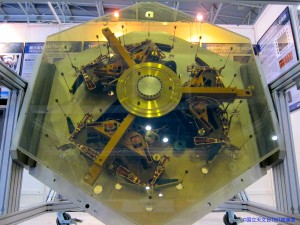TMT Hearing: Native Hawaiian Navigator Testifies

A prototype of what the individual segmented mirrors for the Thirty Meter Telescope will look like upon completion. TMT’s primary mirror will consist of 492 of these hexagonal segmented mirrors. Photo credit: TMT International Observatory.
The Hawai‘i Board of Land and Natural Resources contested case hearing on the Thirty Meter Telescope continued this week in Hilo.
A contested case hearing was requested with respect to the 2011 TMT decision by the BLNR to issue a permit to build the $1.4 billion next-generation telescope near the summit of Mauna Kea .
The Hawai‘i Supreme Court ruled the permit invalid until a contested case hearing could be held to evaluate a petition by a group challenging the project’s approval.
University of Hawai‘i at Hilo witnesses continued to testify in support of building the TMT observatory on Wednesday, Nov. 2.
Native practitioner and navigator Chad Kalepa Baybayan testified about traditional navigation and the use of Mauna Kea from a marine wayfaring perspective.
Baybayan is recognized as a master navigator and is highly respected around the world. He has been a crew member on many sailing vessels, including the double-hulled voyaging canoe Hōkūleʻa.
He has worked with the Polynesian Voyaging Society since 2015, after many years serving as the navigator in residence at ‘Imiloa Astronomy Center in Hilo.
Baybayan’s personal testimony supports the university’s argument that the TMT project has not been inconsistent with the Conservation District Use Application (CDUA) or the cultural considerations related to the criteria requirements.
The witness also testified that the project would not violate the State of Hawai‘i’s duty to protect customary and traditional practice cited in the Hawai‘i State Constitution – Article 12, Section 7.
He described his relationship to Mauna Kea as “deeply spiritual but not religious,” adding that the summit of Mauna Kea has “served as a beacon leading me back to my home and family.”
“My perspective of Mauna Kea is based upon a tradition of ocean exploration and a legacy of a people who left the safety of the shoreline, sailed away and discovered the stars,” Baybayan said.
The first petitioner called to cross-examine Baybayan was Deborah Ward, a member KAHEA: The Hawaiian-Environmental Alliance, a petitioner in the contested case hearing.
Ward did not have any questions for Baybayan, but proceeded to address the 30-minute oral cross-examination ruling made by retired Hawai‘i Island Circuit Court Judge Riki May Amano, the contested case hearing officer, the day before.
Ward requested that Judge Amano make a written ruling, which would enable Ward and other litigants to make a formal motion to reconsider.
Although Baybayan testified in his written and oral testimony that the TMT project meets the criteria for the CDUA, when asked by KAHEA Attorney Dexter Kaiama if he read the CDUA and the Environmental Impact Statement for the TMT project, Baybayan said had not read either document.
Kaima is the attorney representing KAHEA.
Many petitioners questioned Baybayan about the statement, “I firmly believe the highest form of desecration rests in the actions that remove the opportunity and choices from the kind of future our youth can own.”
During C.M. Kahookahi Kanuha’s cross-examination, Baybayan was asked about protests of the project and the arrests that took place in 2015 on Mauna Kea.
Baybayan said people have to stand up for what they believe in and that in this case, part of that process was getting arrested.
When asked, he said it was “absolutely” necessary for natives to define and protect sacred sites.
He added that the events had a tremendous impact on everyone, noting that it was not because it stopped TMT, but because “it shook the confidence of the 13 other telescopes. That, for me, was the real issue,” Baybayan said.
Throughout the hearing, during roll-call, many petitioners expressed their support and solidarity with Native Americans in Standing Rock regarding the North Dakota pipeline.
Kanuha asked Baybayan if he believed building the TMT Observatory is worth bringing a “Standing Rock-like situation” to Mauna Kea here in Hawai‘i. He replied, “Yes. I think it is.”
After Kanuha finished his cross-examination, the room filled with cheering and comments for Kanuha.
Judge Amano, directing her attention to the observers watching the hearing, said, “This is not a circus folks.”
UH-Hilo witness Robert McLaren of the Institute for Astronomy testified about the development of the Mauna Kea Science Reserve.
The BLNR contested case hearing will resume Tuesday Nov. 15, in the Willie K. Crown Room at the Naniloa Hotel on Banyan Drive in Hilo, with UH-Hilo witness Judge Walter Heen and Jessie Eiben.
Heen will testify about the history of UH management of Mauna Kea. Eiben will testify about the biological impact of the TMT project, specifically on the endemic wēkiu bug.
McLaren and UH witness James T. Hayes will return to the stand on Nov. 16.
The BLNR contested case hearing on the TMT project is also scheduled for Nov. 18, and Dec, 1, 2, 5, 6, 8, 9, 12, 13, 16, 19 and 20.
Click here for the entire UH-Hilo witness list.
RELATED LINK
Judge Puts Time Limit on TMT Cross-Examinations
Sponsored Content
Comments








